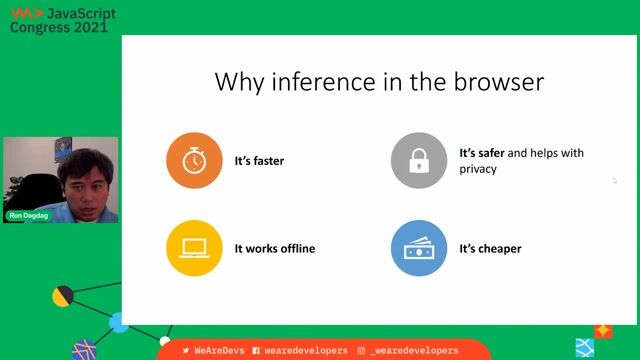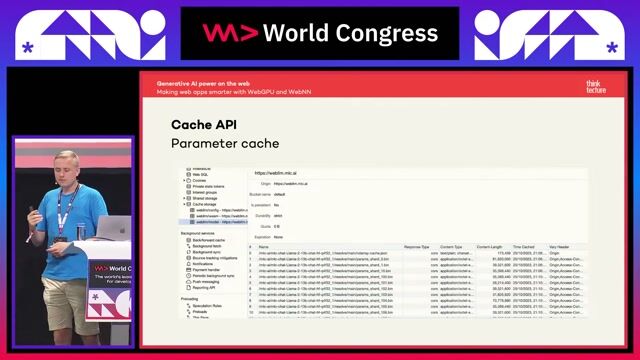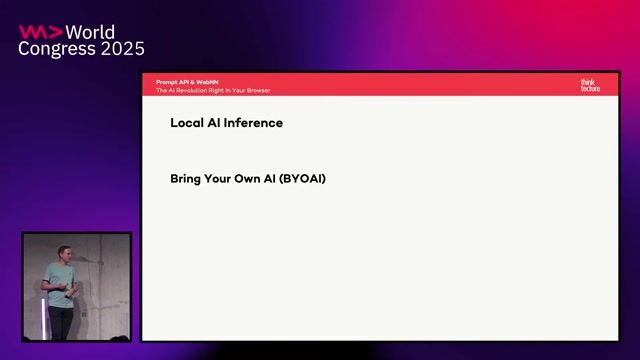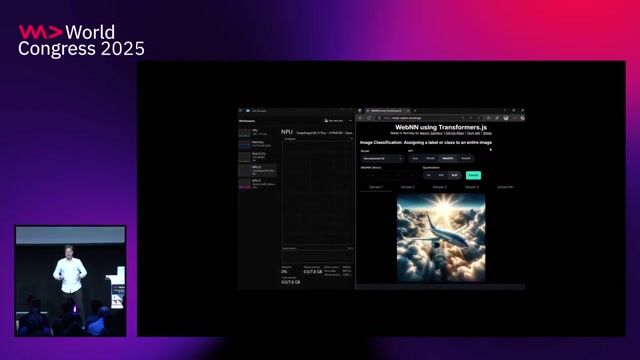Nico Martin
From ML to LLM: On-device AI in the Browser
#1about 2 minutes
Using machine learning to detect verbal filler words
A personal project to detect and count filler words in Swiss German speech highlights the limitations of standard speech-to-text APIs.
#2about 2 minutes
Comparing TensorFlow.js backends for performance
TensorFlow.js performance depends on the chosen backend, with WebGPU offering significant speed improvements over CPU, WebAssembly, and WebGL.
#3about 2 minutes
Real-time face landmark detection with WebGPU
A live demo showcases how the WebGPU backend in TensorFlow.js achieves 30 frames per second for face detection, far outpacing CPU and WebGL.
#4about 1 minute
Building a browser extension for gesture control
A Chrome extension uses a hand landmark detection model to enable website navigation and interaction through pinch gestures.
#5about 2 minutes
Training a custom speech model with Teachable Machine
Teachable Machine provides a no-code interface to train a custom speech command model directly in the browser for recognizing specific words.
#6about 2 minutes
The technical challenges of running LLMs in browsers
To run LLMs on-device, we must understand their internal workings, from tokenizers that convert text to numbers to the massive model weights.
#7about 2 minutes
Reducing LLM size for browser use with quantization
Quantization is a key technique for reducing the file size of LLM weights by using lower-precision numbers, making them feasible for browser deployment.
#8about 2 minutes
Running on-device models with the WebLLM library
The WebLLM library, powered by Apache TVM, simplifies the process of loading and running quantized LLMs directly within a web application.
#9about 2 minutes
A live demo of on-device text generation
A markdown editor demonstrates fast, local text generation using the Gemma 2B model, with all processing happening in the browser without cloud requests.
#10about 1 minute
Mitigating LLM hallucinations with RAG
Retrieval-Augmented Generation (RAG) improves LLM accuracy by providing relevant source documents alongside the user's prompt to ground the response in facts.
#11about 3 minutes
Building an on-device RAG solution for PDFs
A demo application shows how to implement a fully client-side RAG system that processes a PDF and uses vector embeddings to answer questions.
#12about 1 minute
Forcing an LLM to admit when it doesn't know
By instructing the model to only use the provided context, a RAG system can reliably respond that it doesn't know the answer if it's not in the source document.
#13about 2 minutes
The future of on-device AI hardware and APIs
The performance of on-device AI is heavily hardware-dependent, but future improvements in chips (NPUs) and browser APIs like WebNN will broaden access.
#14about 2 minutes
Key benefits of running AI in the browser
Browser-based AI offers significant advantages including privacy by default, zero installation, high interactivity, and infinite scalability since users provide the compute.
Related jobs
Jobs that call for the skills explored in this talk.
Matching moments

18:18 MIN
Web performance gaps and AI's struggle with logic
WeAreDevelopers LIVE – Web Scraping, Agents, Actors and more

00:02 MIN
Introduction to generative AI in the browser
Generate AI in the Browser with Chrome AI - Raymond Camden

31:13 MIN
Running on-device AI in the browser with Gemini Nano
Exploring Google Gemini and Generative AI

33:35 MIN
Performing inference in the browser with ONNX Runtime Web
Making neural networks portable with ONNX

33:57 MIN
Implementing on-device AI with the Chrome AI API
WeAreDevelopers LIVE – AI vs the Web & AI in Browsers

13:51 MIN
The technology behind in-browser AI execution
Generative AI power on the web: making web apps smarter with WebGPU and WebNN

02:42 MIN
Two primary approaches for browser-based AI
Prompt API & WebNN: The AI Revolution Right in Your Browser

00:17 MIN
Building a custom voice AI with WebRTC and Google APIs
Raise your voice!
Featured Partners
Related Videos
 30:36
30:36Prompt API & WebNN: The AI Revolution Right in Your Browser
Christian Liebel
 32:27
32:27Generative AI power on the web: making web apps smarter with WebGPU and WebNN
Christian Liebel
 33:51
33:51Exploring the Future of Web AI with Google
Thomas Steiner
 53:46
53:46WeAreDevelopers LIVE – AI vs the Web & AI in Browsers
Chris Heilmann, Daniel Cranney & Raymond Camden
 30:13
30:13Privacy-first in-browser Generative AI web apps: offline-ready, future-proof, standards-based
Maxim Salnikov
Generate AI in the Browser with Chrome AI - Raymond Camden
Raymond Camden
 25:17
25:17AI: Superhero or Supervillain? How and Why with Scott Hanselman
Scott Hanselman
 34:34
34:34Vision for Websites: Training Your Frontend to See
Daniel Madalitso Phiri
Related Articles
View all articles



From learning to earning
Jobs that call for the skills explored in this talk.

AIML -Machine Learning Research, DMLI
Apple
Zürich, Switzerland
Python
PyTorch
TensorFlow
Machine Learning
Natural Language Processing

Web Developer (short-term, 2 months) In Open-Source Machine Learning
Eindhoven University of Technology
Eindhoven, Netherlands
Remote
React
Plotly
Next.js
Machine Learning

Machine Learning Engineer - Large Language Models (LLM) - Startup
Startup
Charing Cross, United Kingdom
PyTorch
Machine Learning

AI & Embedded ML Engineer (Real-Time Edge Optimization)
autonomous-teaming
Canton of Toulouse-5, France
Remote
C++
GIT
Linux
Python
+1

AI & Embedded ML Engineer (Real-Time Edge Optimization)
autonomous-teaming
München, Germany
Remote
C++
GIT
Linux
Python
+1

NodeJS Software Engineer - Conversational AI
MANGO
Palau-solità i Plegamans, Spain
API
Azure
Redis
Node.js
Salesforce
+6

ML Data Engineer - Object Detection & Active Learning
autonomous-teaming
München, Germany
Remote
ETL
NoSQL
NumPy
Python
+3

